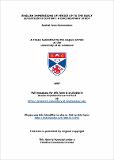Files in this item
English impressions of Venice up to the early seventeenth century: a documentary study
Item metadata
| dc.contributor.advisor | Rhodes, Neil | |
| dc.contributor.advisor | Falconer, Alexander Frederick | |
| dc.contributor.author | Hammerton, Rachel Joan | |
| dc.coverage.spatial | 538 | en_US |
| dc.date.accessioned | 2012-06-15T14:43:19Z | |
| dc.date.available | 2012-06-15T14:43:19Z | |
| dc.date.issued | 1987 | |
| dc.identifier.uri | https://hdl.handle.net/10023/2792 | |
| dc.description.abstract | The first Englishmen to write about the city-state of Venice were the pilgrims passing through on their way to the Holy Land. Their impressions are recorded in the travel diaries and collections of advice for prospective fellow pilgrims between the early fourteenth and early sixteenth centuries, the most substantial being those of William Wey, Sir Richard Guylforde and Sir Richard Torkington, who visited Venice in 1458 and '62, 1506, and 1517 respectively. In the 1540s arrived the men who saw Venice as part of the new Europe--Andrew Borde and William Thomas. Thomas's study of the Venetian state emphasized the efficiency of its administration, seeing it as an example of constructive government, where effective organisation for the common good led directly to national stability and prosperity. The mid-sixteenth century saw the beginnings of Venice as a tourist centre; the visitors who came between 1550 and the end of the century described the sights and the people, the traditions and way of life. Fynes Moryson's extensive account details what could be seen and learned in the city by an observant and enquiring visitor. In addition to information available in first-hand accounts of Venice, much could be learned from the work of the late sixteenth-century English translators. Linguistic, cultural, geographical, historical and literary translations yielded further knowledge and, more importantly, new perspectives, Venice being seen through the eyes of Italians and, through Lewkenor's comprehensive work, The Commonwealth and Government of Venice, of Venetians themselves. Finally, to assess the general impressions of Venice and the Venetians, we consider the literature of the turn of the sixteenth-seventeenth century; what, and how much, of the three-hundred year accumulation of knowledge of the city and people of Venice had most caught the attention and imagination of the English mind, and how close was the relationship between the popular impression and the documentary information from which it had largely developed. | en_US |
| dc.language.iso | en | en_US |
| dc.publisher | University of St Andrews | |
| dc.rights | Creative Commons Attribution-NonCommercial-NoDerivs 3.0 Unported | |
| dc.rights.uri | http://creativecommons.org/licenses/by-nc-nd/3.0/ | |
| dc.subject.lcc | PR429.V3H2 | |
| dc.subject.lcsh | English literature--Early modern, 1500-1700--History and criticism | en_US |
| dc.title | English impressions of Venice up to the early seventeenth century: a documentary study | en_US |
| dc.type | Thesis | en_US |
| dc.type.qualificationlevel | Doctoral | en_US |
| dc.type.qualificationname | PhD Doctor of Philosophy | en_US |
| dc.publisher.institution | The University of St Andrews | en_US |
This item appears in the following Collection(s)
Except where otherwise noted within the work, this item's licence for re-use is described as Creative Commons Attribution-NonCommercial-NoDerivs 3.0 Unported
Items in the St Andrews Research Repository are protected by copyright, with all rights reserved, unless otherwise indicated.


